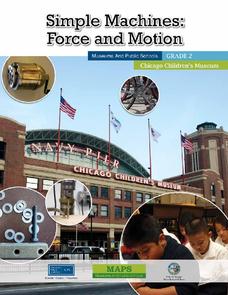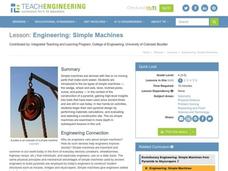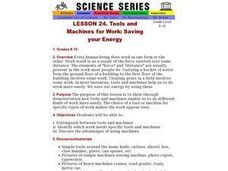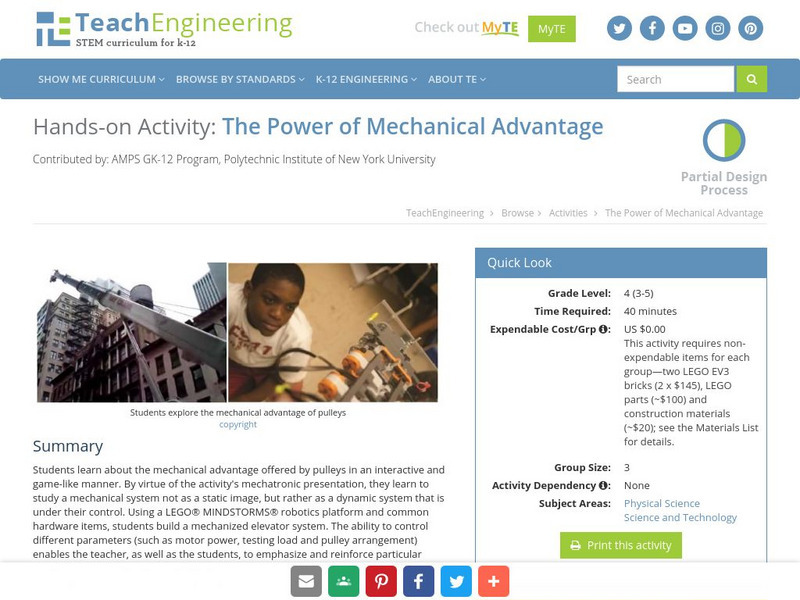Curated OER
Lift and Pull
Students examine the mechanical advantage of pulleys. For this pulleys lesson students are given a challenge to help save a whale by setting up different pulleys systems to move it.
Science Companion
Simple Machines Design Project
Make your work as a teacher a little easier with a physical science project on simple machines. After introducing young scientists to these devices and identifying their different uses around the school, this project engages...
Curated OER
Simple Machines
Eighth graders work together in groups to introduce themselves to the six types of simple machines. They are to record what the machine does, its mechanical advantage and identify real world situations in which they are used. They...
Colorado Unit Writing Project
Simple Machines
Planning an elementary science unit has never been simpler! These twelve lessons guide young scientists through an exploration of simple machines and their many uses in the real world before asking them to apply their learning...
Curated OER
Simple Machines and Modern Day Engineering Analogies
Students apply the mechanical advantages and problem-solving capabilities of six types of simple machines (wedge, wheel and axle, lever, inclined plane, screw, pulley) as they discuss modern structures in the spirit of the engineers and...
Agriculture in the Classroom
Six Kinds Do It All
Teach young engineers that all machines, no matter how complicated or complex, are made up of just six simple devices with this hands-on physical science lesson. Using the included templates, students first create paper models of...
Chicago Children's Museum
Simple Machines: Force and Motion
Get things moving with this elementary science unit on simple machines. Through a series of nine lessons including teacher demonstrations, hands-on activities, and science experiments, young scientists learn about forces, motion,...
Curated OER
Simple Machines
In this physics worksheet, students use the clues given on the sheet to complete the crossword puzzle on simple machines. There are 18 clues to solve in the puzzle.
Curated OER
Simple Machines
Students create a pyramid design based on the 6 simple machines that they are introduced to. In this simple machines lesson plan, students are introduced to the wedge, wheel and axle, inclined plane, screw, and pulley.
Teach Engineering
A Simple Solution for the Circus
Class members are challenged to design a device that will move a circus elephant into a train car. Groups brainstorm ideas that use simple machines to load the elephant. They then choose one of their ideas, sketch a plan, and present it...
Curated OER
Machines
In this machines worksheet, students review different types of simple machines including pulleys, wedges, levers, and inclined planes. This worksheet has 10 matching, 4 multiple choice, and 8 short answer questions.
Curated OER
Simple Machine Test
Students complete several worksheets about machines. In this machine lesson students complete several handouts that describe the different machines and how pulleys work.
Curated OER
Simple Machines - Graphics, Experiments, Animation
Twelfth graders display simple machines through the use of graphics, experiments, and animation. They apply problem solving and design and skills.
Curated OER
Engineering: Simple Machines
Fourth graders participate in activities to examine how simple machines help build things. They identify the six types of simple machines. They discover how simple machines where use historically to build pyramids and how they are still...
Curated OER
Challenger's Lost Lessons - The Lost Simple Machines Lesson
Students investigate the characteristics of simple machines. In this simple machine lesson, students investigate work as a product of applying constant force. They answer questions about what happens on Earth and what may have happened...
Curated OER
Block and Tackle
Students simulate block and tackles to lift heavy objects. They lift cargo by hand with the whip and the two-fold purchase to simujlate what crew members do aboard ships. They measure the effort and distance pulled for a gun tackle, luff...
Curated OER
Tools and Machines for Work: Saving your Energy
Students consider how tools and machines can make work easier. They examine specific tools for making work easier.
TeachEngineering
Teach Engineering: The Power of Mechanical Advantage
Students learn about the mechanical advantage offered by pulleys in an interactive and game-like manner. By virtue of the activity's mechatronic presentation, they learn to study a mechanical system not as a static image, but rather as a...
CK-12 Foundation
Ck 12: Physical Science: Mechanical Advantage
[Free Registration/Login may be required to access all resource tools.] Actual and ideal mechanical advantage, how to calculate them and the mechanical advantage of different types of machines.
Ohio State University
Ohio State Univ.: Simple Machines & Mechanical Advantage [Pdf]
This site details how simple machines create a mechanical advantage for humans. Levers, theoretical mechanical advantage, actual mechanical advantage, and pulley systems are discussed.
Integrated Publishing
Integrated Publishing: How Mechanical Advantage Is Used
Describes how pulley systems are used in the real world, including the role of the mechanical advantage in selecting the proper pulley system.
TeachEngineering
Teach Engineering: Pulley'ing Your Own Weight
Using common materials (spools, string, soap), students learn how a pulley can be used to easily change the direction of a force, making the moving of large objects easier. They see the difference between fixed and movable pulleys, and...
TeachEngineering
Teach Engineering: Powerful Pulleys
Students continue to explore the story of building a pyramid, learning about the simple machine called a pulley. They learn how a pulley can be used to change the direction of applied forces and move/lift extremely heavy objects, and the...
Science Education Resource Center at Carleton College
Serc: Comparing Mechanical Advantage and Efficiency of Pulleys
Young scholars determine the mechanical advantage of three pulley set-ups. Then they measure the work input and output to calculate the efficiency. Finally, students determine the relationship between the mechanical advantage and the...



















![Ohio State Univ.: Simple Machines & Mechanical Advantage [Pdf] Handout Ohio State Univ.: Simple Machines & Mechanical Advantage [Pdf] Handout](https://d15y2dacu3jp90.cloudfront.net/images/attachment_defaults/resource/large/FPO-knovation.png)



